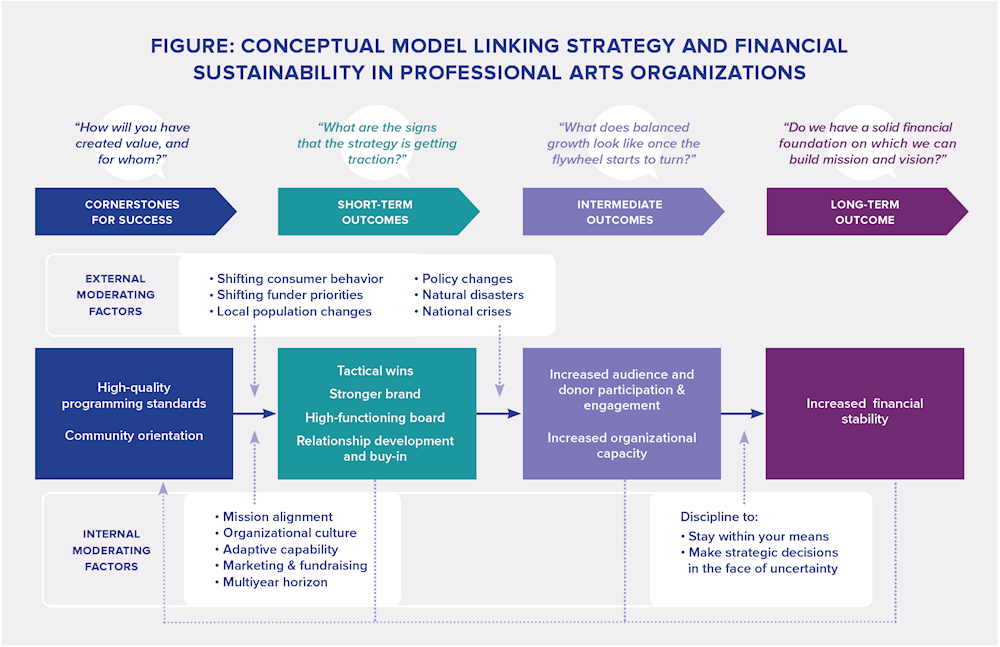The Alchemy of High-Performing Arts Organizations
This report, published in partnership with The Wallace Foundation, studies 10 organizations with a track record of high performance and 10 who engineered a turnaround from low to high performance.

By Dr. Zannie Voss, Director of SMU DataArts and Dr. Glenn Voss, Research Director of SMU DataArts. Commissioned by the Wallace Foundation.
How does an arts organization become financially stable?
How do high-performing arts organizations maintain their magic?
What does it take for a struggling organization to turn its fortunes around and become high performing?
Executive Summary
This paper, based on research conducted from mid-January to mid-March 2020, investigates elements of successful strategies that can be considered for replication or adaptation by others. Specifically, we examined the following research questions: 1) What are examples of visual and performing arts organizations that have financially out-performed others in substantial ways, as well as examples of those that came close to shutting down or were in the bottom ranking of performers but engineered a financial turnaround? 2) What kinds of strategies were used to achieve this financial performance? and 3) Were there particular contexts or conditions in which these strategies seemed to be more effective?
To answer these questions, we first identified 10 organizations with a long track record of high performance along seven financial and operating metrics and 10 organizations that successfully engineered a turnaround from low to high performance on these same metrics in recent years.1 Our approach to identifying and understanding high-performing organizations is through stochastic frontier analysis, an analytic method that allows us to explore the frontier of highest feasible performance given the characteristics of each organization and the community in which it operates.
To understand how those organizations achieved high performance, we then conducted interviews with organizational leaders in both cohorts. In speaking to their strategies and plans, they described a kind of “mental map,” or playbook, linking choices and decisions to outcomes. The synthesis of shared elements across those mental maps forms the basis of these findings:
Key Findings

- The cornerstones of high performance appear to lie in the alchemy of high standards in the creation of work that is meaningful to the local community. While this deceptively simple statement may reflect universal intentions, executing on it, according to these organizational leaders, takes humility and an intensive investment of resources and time.
- Strong cornerstones of a strategic vision lead to these short-term outcomes: tactical wins that inspire confidence and excitement, a stronger brand, a high-functioning board, and community relationship development and buy-in.
- A number of internal factors moderate or regulate the organization’s ability to translate these cornerstones into positive short-term outcomes, including mission alignment, a healthy culture that invites participation, adaptive capabilities, investments in marketing and fundraising, and a multiyear horizon. Turnaround organization leaders particularly emphasized a strong plan with organization-wide buy-in as being critical to their ability to rebound. Environmental factors such as shifting consumer behavior and funder priorities, local population and policy changes, natural disasters, and national crises also affect an organization’s ability to achieve short-term gains.
- Short-term outcomes provide a feedback loop that reinforces the cornerstones of strategic vision and translates into intermediate outcomes of increased organizational capacity and increased audience and donor participation and engagement. These resource and relationship wins reinforce an organization’s community orientation and advance its ability to achieve high programming standards. Environmental factors again affect an organization’s ability to translate short-term gains into intermediate outcomes.
- Intermediate outcomes also lead to financial sustainability provided the organization has discipline. Arts and cultural organizations exist for mission fulfillment, not financial sustainability. Yet the long-term outcome of financial sustainability undergirds the ability to maximize mission success.
This white paper is designed to provide guidance to organizations that seek a path linking strategy and financial sustainability.
WEBINAR RECORDING
Community Conversations: The Alchemy of High-Performing Arts Organizations
ABOUT THE WALLACE FOUNDATION
The Wallace Foundation works to support and share effective ideas and practices to foster improvements in learning and enrichment for children and the vitality of the arts for everyone. Its objectives are to improve the quality of schools, primarily by developing and placing effective principals in high-need schools, promoting social and emotional learning in elementary school and out-of-school-time settings, expanding opportunities for high-quality summer learning, reimagining and expanding access to arts learning, and building audiences for the arts. The Foundation seeks to generate knowledge and insights from these efforts to enhance policy and practice nationwide. For more information and research on these and related topics, please visit the Foundation’s Knowledge Center at wallacefoundation.org.
ABOUT SMU DATAARTS
SMU DataArts, the National Center for Arts Research, is a joint project of the Meadows School of the Arts and Cox School of Business at Southern Methodist University. SMU DataArts compiles and analyzes data on arts organizations and their communities nationwide and develops reports on important issues in arts management and patronage. Its findings are available free of charge to arts leaders, funders, policymakers, researchers and the general public. The vision of SMU DataArts is to build a national culture of data-driven decision-making for those who want to see the arts and culture sector thrive. Its mission is to empower arts and cultural leaders with high-quality data and evidence-based resources and insights that help them to overcome challenges and increase impact. To work toward these goals, SMU DataArts integrates data from its Cultural Data Profile, its partner TRG Arts, and other national and government sources such as Theatre Communications Group, the National Endowment for the Arts, the Census Bureau, and IRS 990s. Publications include white papers on emergence from the COVID-19 crisis, culturally specific arts organizations, protecting arts organizations through downturns, gender equity in art museum directorships, and more. SMU DataArts also publishes reports on the health of the U.S. arts and cultural sector and the annual Arts Vibrancy Index, which highlights the 40 most arts-vibrant communities around the country.